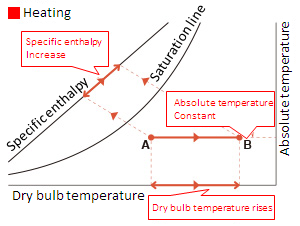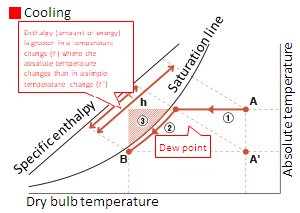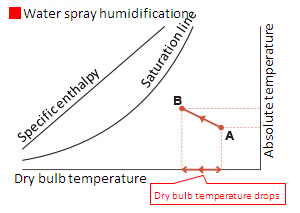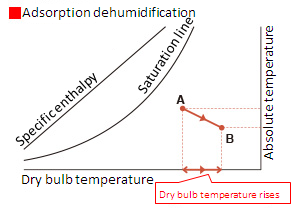Control Panel Cooling units Technical Information
3-11. Air conditioning process and psychrometric chart
Movement on the psychrometric chart of the air conditioning process
Heating
Heating includes "resistance heating", "far-infrared heating", and "induction heating", but the movement on the psychrometric chart is basically the same.
When air is heated using an electric heater, the dry-bulb temperature rises, but the amount of water vapor contained in the air does not change.
In other words, only the temperature rises while the absolute humidity remains constant, so the state line representing the process becomes horizontal as shown in the right figure.
Such changes are called "sensible heat changes".
At this time, the heat quantity of the air also increases from A to B, and the specific enthalpy as the heat quantity difference increases.

Cooling
Cooling is not just about lowering the temperature, there are "cooling dehumidification" that dehumidifies when cooling and "cooling humidification" that humidifies conversely.
Such a change in temperature accompanied by a change in absolute humidity causes a large amount of change in enthalpy.
Here, let's compare the enthalpy in the right figure when the humid air of A (absolute humidity: high) and A' (absolute humidity: low) are in the same temperature and humidity state of B.
Looking at the specific enthalpy h required to transform A into B and the specific enthalpy h' required to transform A' into B, it is clear that h is larger.
In other words, you can see that cooling while dehumidifying requires more energy.
Also, a very large amount of energy is required for temperature control that accompanies changes in absolute humidity.

Humidification
Humidification methods are roughly divided into “steam type humidification” and “water spray humidification”.
In order to fully understand humidification, a fairly specialized explanation is required, so here we will use a psychrometric chart to explain the air conditioning process when using an actual humidifier.
Steam type humidification methods are generally pan type humidifiers that humidify the water in a container by heating it with an electric heater and evaporating it.
Steam type humidification releases water vapor at temperatures near 100°C into the air, increasing the ambient temperature.
Water spray humidification is humidification by spraying water into the air and vaporizing it.
Typical humidification methods include the ultrasonic method and the high-pressure vaporization method.
In this method, the heat in the air is taken away by the latent heat when the moisture sprayed in the air changes its state to water vapor, so the temperature of the air drops as shown in the right figure.


Dehumidification
Dehumidification can be roughly divided into two methods.
One is "cooling dehumidification" mentioned in the "cooling" section, and the other is "adsorption dehumidification".
Here, we will explain the adsorption dehumidification method.
Unlike cooling dehumidification, adsorption dehumidification has a considerably high dehumidification capacity, and theoretically it can be reduced to 0%.
However, "chemisorption type" such as silica gel must remove moisture in order to restore moisture absorption, and exhaust heat is generated at that time.
Also running costs such as electricity bills will also increase.

Previous item: 3-10. Psychrometric Chart
We're here to give you quick answers to your questions.
